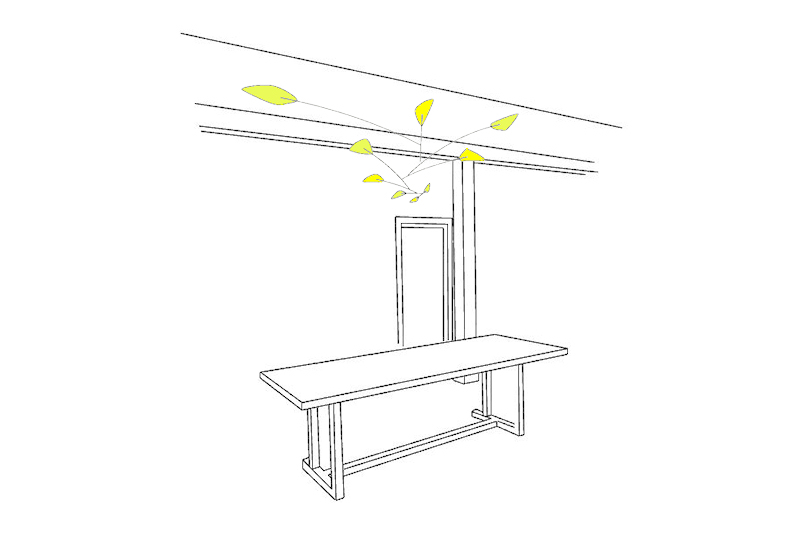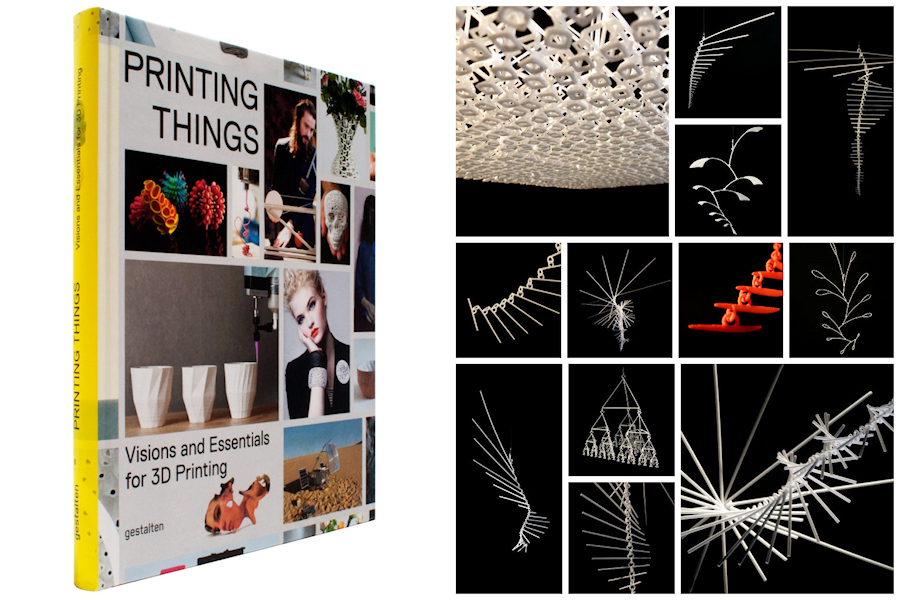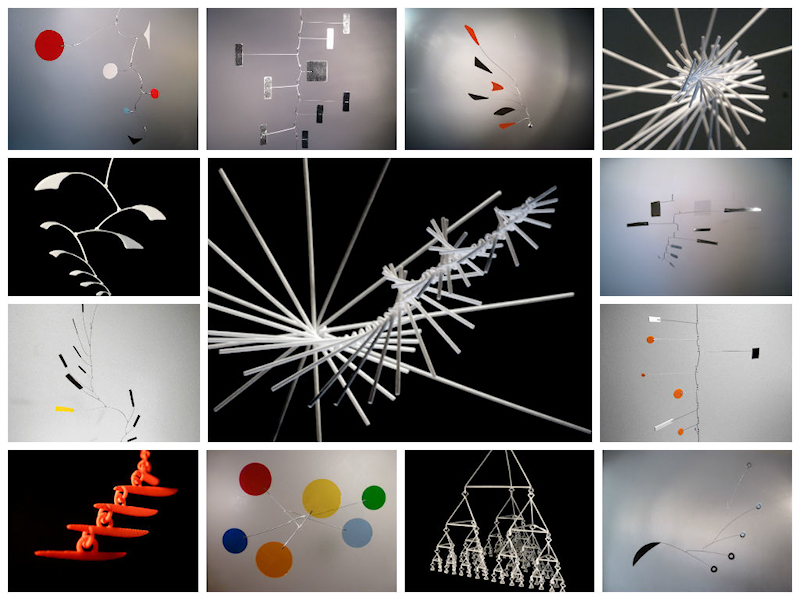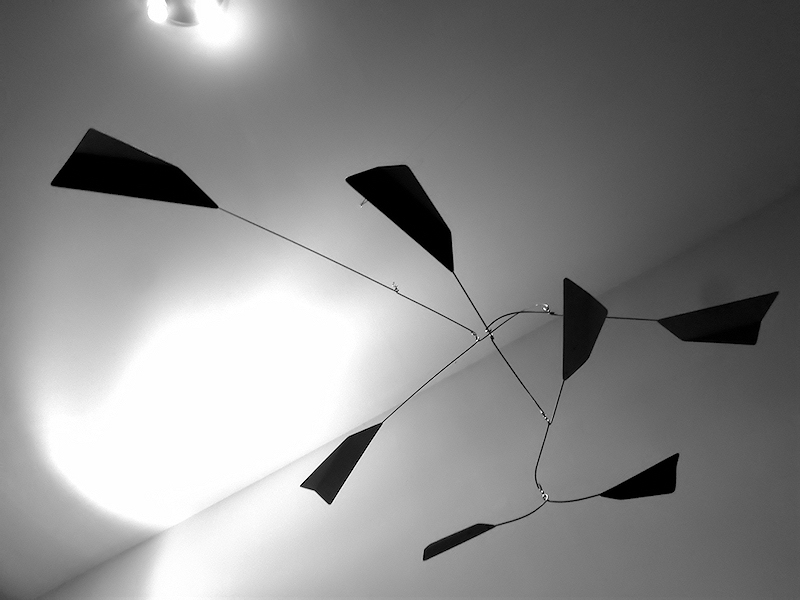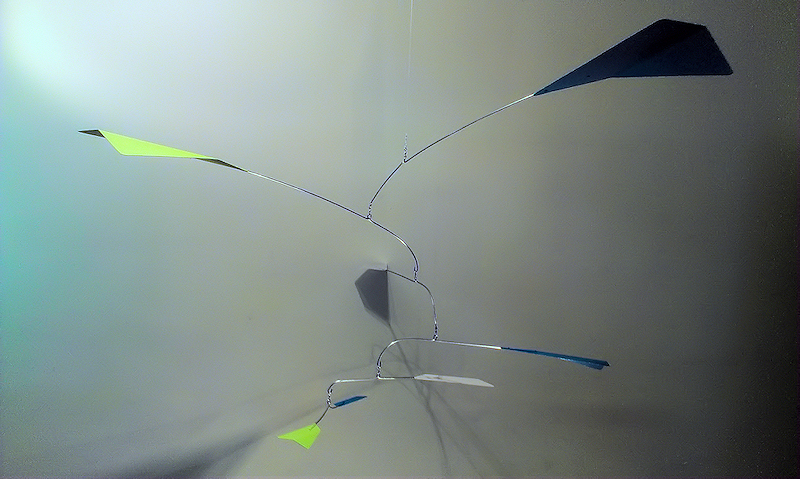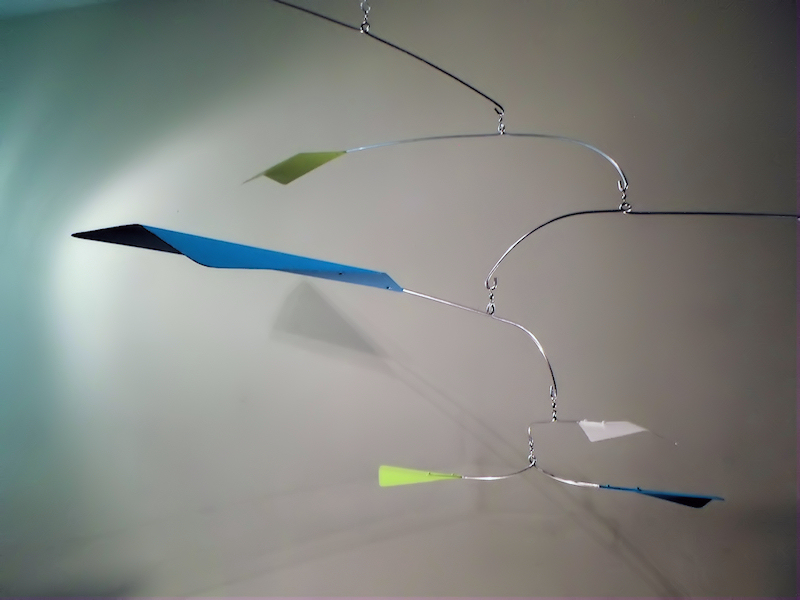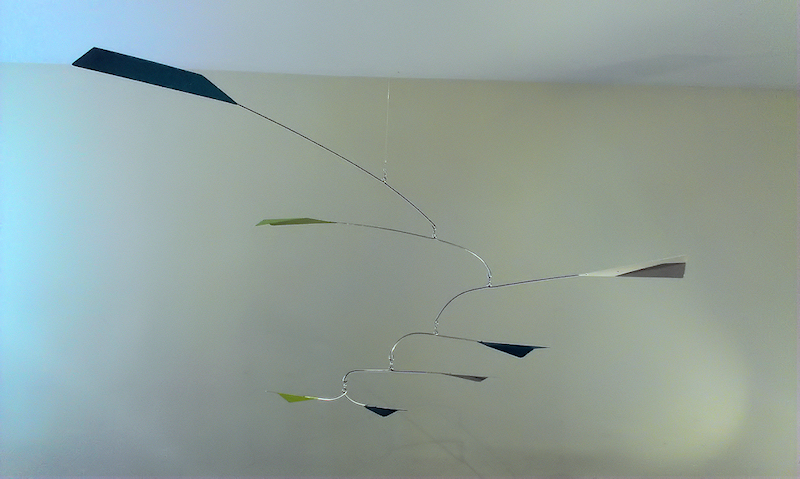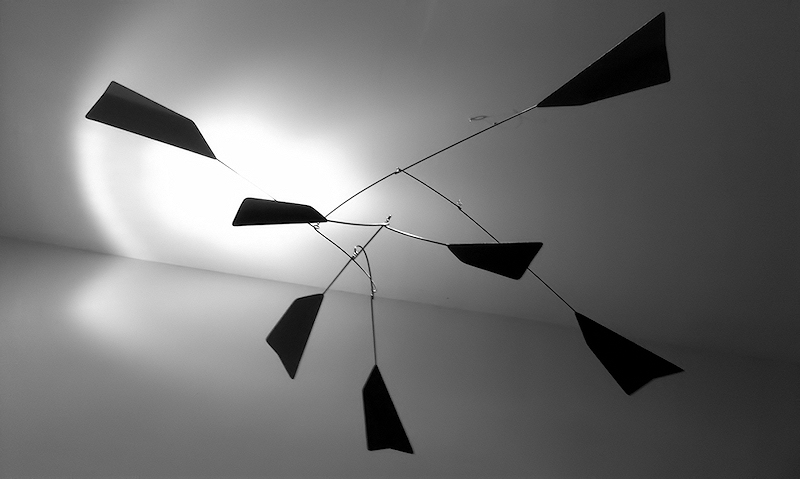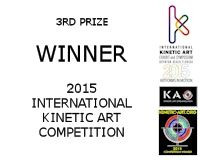Drawing of a custom Calder-like mobile above a conference table
Just a drawing I just made for a custom Calder-like mobile above a conference table:
– See more of my custom mobiles or read more of my blog about mobiles –
3D Printed Mobiles in new book “Printing Things – Visions and Essentials for 3D Printing”
Our 3d printed mobiles are in a new book by publisher and creative agency Gestalten titled Printing Things – Visions and Essentials for 3D Printing. It’s an inspirational and understandable exploration of the creative potential of 3D printing that introduces outstanding projects, key experts, and the newest technologies.
From the Book:
Kinetic Structures, Virtually Balanced: The term “mobile” was first used in 1931 by Marcel Duchamp to describe the kinetic wire-frames made by Alexander Calder, whose iconic works later sparked an entire genre of sculpture. These works were created in situ, taking advantage of ambient air currents and finely calibrated equilibriums to generate large constructions, both dynamic and serene in their movements. In the years that followed, the art form became archetypal, but the advent of sophisticated design and engineering software has allowed for unprecedented methods of working in the medium. A collaboration arose between kinetic sculptor Marco Mahler and Henry Segerman, an assistant professor of mathematics, on the question of advanced modeling for the creation of rapid prototyped mobiles. Communicating exclusively via email, Skype and Twitter, the two were united by the shared interest in a mobile emerging fully assembled from a single print, the separate parts already interconnected. The precision of the printing technology allowed them to calibrate the balance to the micron (one one-thousandth of a millimeter), slightly modifying the thickness of certain elements to generate different bearing. They also experimented with scripted modeling in the Python programming language to increase the limits of intricacy, for instance with the 1365 pieces that make up the Quaternary Tree Mobile Level 6. Finally they uploaded their designs to Shapeways, transforming the mobile from a delicate one-off to a geometric code available for materialization on demand.
About the Book:
3D?printers will soon be found in more and more workshops, offices, and homes. With them, we will be able to print out small pieces of furniture, prototypes, replacement parts, and even a new toothbrush on-site at any time. Consequently, new production methods and business models are developing—along with a new visual language of multidimensional formal explorations. Today, 3D objects and complex forms can already be printed out that were previously impossible to achieve with traditional methods.
Printing Things is an inspirational and understandable exploration of the creative potential of 3D printing. The book not only introduces outstanding projects, key experts, and the newest technologies, but it also delves into the complex topics that these paradigm-shifting technologies bring up, such as how to handle copyrights and seamless manufacturing.
– Read the review on designboom –
Two Original Calder Mobiles for Sale on May 13th 2014
Christie’s Post-War and Contemporary Evening Sale on May 13th 2014 at Rockefeller Plaza in New York City will include two Calder mobiles, one hanging and one standing.
Poisson volant (Flying Fish)
hanging mobile
1957
signed with initials and dated ‘CA 57’
24 x 89 x 40 in. (60.9 x 226 x 101.6 cm.)
From the collection of Edwin A. and Lindy (Betty) Bergman
Expected auction price $9,000,000 – $12,000,000
[Update: it sold for $25,925,000 tonight (May 13th 2014) – a new world auction record for Calder – bought by Xin Li on behalf of a Chinese client]
From the catalogue: Alexander Calder’s remarkable sculpture, Poisson volant (Flying Fish), amply demonstrates the breadth and diversity of the artist’s prolific career. The sleek black outline of the fish combined with the complex construction of animated elements that comprise the fish tail demonstrate the artist’s unique compositional ability, unsurpassed technical execution and sheer sense of joie de vivre in one memorable work. Although much of Calder’s work was defiantly non-referential, the fish motif was one that occurred throughout his life; from Steel Fish, one of the artist’s early standing mobiles he created in 1934, to the themed headboard he made for Peggy Guggenheim in 1945, and continuing with his large scale mobiles and stabiles, such as the present work and Yellow Whale created during the late 1950s, the symbolic nature of the fish seemed to encompass much of what Calder wanted to achieve in his unique brand of sculpture.
Dominated by its dramatic silhouette, Poisson volant skillfully combines the monumentality of Calder’s large-scale sculptures with the delicacy of his legendary mobiles. The striking appearance of the fish’s curved body is tempered by the hypnotic nature of the fish’s eye, which Calder beautifully fashions out of a tightly coiled piece of steel wire. The monumentality of the fish’s body is then tempered by the dramatic fourish of fishy tale — a highly dynamic collection of more than a dozen individuality fabricated and assembled elements, which, when moved by a passing breeze, spring into life with all the zeal of fish darting through the water. Working on both the vertical and horizontal plane, Poisson volant is one of Calder’s most complex works as both aesthetically and structurally, his arrangement of elements work together to produce an effect that delights and amazes as it becomes a symphony of movement and joy.
By taking the fish as his subject matter, Calder is building on a custom that dates back to the very earliest days of human civilization. The fish has acquired an important role in many of the world’s great faiths and religions. In the West, the earliest use of the fish as a symbolic object was made by the Christian theologian Clement of Alexandria (born circa 150) who encouraged his readers to place the image of a fish in their personal seals. The origin of the fish’s status in the Christian faith has been traced
back to the miracle of the Feeding of the Five Thousand (the only miracle to appear in all four Gospels) in which Jesus feeds a large crowd of people with just five loaves and two fish. In the Eastern tradition, the fish is one of the eight Buddhist symbols of good fortune, and in many faiths acts as a representation of abundance and wealth. Linked to the idea that water is the giver of life, the fish has become associated with sustenance and nourishment and also linked to health, wealth and prosperity.
But for Calder, the fish was symbolic of the serene and graceful movement that he was trying to emulate in his work. After centuries of being constrained by its static traditions, Calder wanted to release sculpture from these confines and introduce a fourth dimension to the work—that of movement. The resulting body of work, of which this piece is arguably one of the most accomplished examples, gave Calder the opportunity to fully explore the kinetic possibilities of sculpture and produce three-dimensional worlds that were in constant fux. As he once said, “A mobile is a feisty thing and seldom stays tranquilly in one place. …A mobile in motion leaves an individual wake behind it , or rather, each element leaves an individual wake behind its individual self. Sometimes these wakes are contracted within each other, and sometimes they are deployed” (A. Calder, quoted by M. Prather, Alexander Calder 1898-1976, Washington, 1998, p. 137).
He first began to explore the aesthetic possibilities of the fish form in 1929 with his exquisitely delicate work, Goldfsh Bowl. By 1934, it appeared again in his large-scale sculptures, and in the summer of that year, buoyed by the warm temperatures and his recent move to an old farmhouse he’d purchased in Connecticut, Calder produced a monumental outdoor sculpture called Steel Fish. Many of these early complex constructions coincide with the organic imagery of Joan Miró and Paul Klee. Calder and Miró formed a lifelong friendship after the pair first met in Paris in 1928 and lasted until Calder’s death in 1976. But as Miró’s work became more symbolic, Calder’s became more abstract. Although his piscine forms were making more frequent appearances in his oeuvre, these pieces often merely allude to forms without following them implicitly. When these new works were shown at the Pierre Matisse Gallery in New York in 1937, a critic asked Calder to define the significance of these new organic forms. He replied, “I don’t really think that the thing can be reduced to a formula. Each thing I make has, according to its degrees of success, a plastic quality, which includes many things… These things may be related, and doubtless are, but I have formed no theories about the relation. An idea which will lead me to make a new ‘object’ may come from almost anywhere, from anything” (A. Calder, quoted in M. Prather, Alexander Calder 1898-1976, Washington, 1998, p. 138).
Calder’s use of this form was to reach a wider audience when, in 1939, he was commissioned by the Museum of Modern Art to produce a work for their new building in New York. The result was the spectacular Lobster Trap and Fish Tail. This consisted of a cascade of black organic elements that would become one of his trademark arrangements, and along with a wire cage-like trap and a bright red lure, this work was his largest hanging mobile to date—and the commission that launched Calder’s career as a publicly known artist. The success of Lobster Trap and Fish Tail also meant that Calder had become a critical, as well as a commercial success. Four years later, when the Museum of Modern Art staged a retrospective of his work, he became the youngest artist ever to have been accorded the honor, an event that was to propel him into the ranks of America’s most influential living artists.
Although the fish form proved to be the perfect vehicle for enabling him to express his interest in the spontaneity and kinetic nature of his sculpture, it also enabled him to indulge in the whimsical and more intimate side of his work. In the winter of 1945-46, Peggy Guggenheim, the socialite and art collector, commissioned Calder to make her a silver headboard for her apartment in New York. Calder chose to craft for her a magical, shimmering depiction of an underwater garden. He included two simple fish motifs in the bottom left of the work, closest to where Peggy Guggenheim would have entered the room. In an added touch of whimsy, the fish were not part of the work itself, but attached to it by thin wires, which meant that they would move and shimmer with every gust of wind or each time someone entered or left the room. Peggy Guggenheim became particularly fond of Calder’s work containing his fish motif. A large, fish mobile hung in the drawing room of her apartment and often became a talking point during her glamorous cocktail parties.
Perhaps fittingly, the piscine motif that had been so central to almost half a century of Calder’s work is also the key theme in one of Calder’s final commissions. Untitled (1976) is a large mobile specially made for the Trustees of the National Gallery of Art in Washington, D.C. to hang in the atrium of their new East Building. It is comprised of a majestic collection of black, red and blue forms suspended below a shimmering glass ceiling; the effect of the sunlight bouncing off these gently moving multicolored forms evokes the sight of tropical fish swimming in shallow pools of sun-drenched water. Of all of Calder’s forms, in terms of its size, complexity and sheer delight, Poisson volant is clearly one of the most accomplished sculptures of his career. Its monumental size and graceful and majestic movement is a supreme example of Calder’s skill not just as an engineer, but also as an artist who took a thousand years of sculptural tradition and turned it upside down, and in doing so created some of the most innovative and influential works of the past one hundred years. As the artist himself once said “When everything goes right, a mobile is a piece of poetry that dances with the joy of life and surprises” (A. Calder, Calder, London, 2004, p. 261).
___________
Also for sale:
Untitled
standing mobile
1945
Expected auction price $900,000 – $1,200,000
Behind the Virtual Storefront: Interview with mobile maker and Etsy seller Marco Mahler
Artist, printmaker and writer Aijung Kim is running a series of interviews with Etsy sellers titled “Behind the Virtual Storefront” in connection with a workshop on Etsy Seller Basics that she is teaching at the VMFA Studio School. She was so nice to ask me to participate:
“I discovered Marco’s shop when I typed “Richmond, VA” in the “Shop Local” feature on Etsy. Marco Mahler’s shop, ArtMobile, intrigued me because fine art mobiles like his are an unusual item to find on Etsy, and he takes great photographs of his work. His mobiles are fun and stylish, and pretty classy-looking if I do say so myself. His 3d-printed mobiles are apparently the first of their kind! Also, I don’t see that many guy sellers on Etsy, so his shop stood out to me for that reason, too. I hope you enjoy reading the interview with Marco. Turns out he’s pretty business-savvy. I learned a lot from reading his answers. Enjoy!”
Photos of a custom mobile I finished last week
Photos of a custom mobile I finished last week for a private residence in Florida (via CAD International):
The design is inspired by the architecture of the Butterfield House in New York City for which I previously made a custom mobile.

